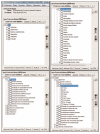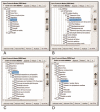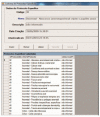MULTIPROFESSIONAL ELECTRONIC PROTOCOL FOR DIGESTIVE SURGERY VALIDATION
- PMID: 34669879
- PMCID: PMC8521891
- DOI: 10.1590/0102-672020210002e1583
MULTIPROFESSIONAL ELECTRONIC PROTOCOL FOR DIGESTIVE SURGERY VALIDATION
Abstract
Background: The creation of a computerized clinical database with the ability to collect prospective information from patients and with the possibility of rescue and crossing data enables scientific studies of higher quality and credibility in less time.
Aim: To validate, in a single master protocol, the clinical data referring to Surgery of Digestive System in a multidisciplinary way, incorporating in the SINPE© platform, and to verify the incidence of digestive diseases based on the prospectively performed collections.
Method: Organize in one software, in a standardized structure, all the pre-existing items in the SINPE© database; the theoretical basis was computerized through the MIGRASINPE© module creating a single multiprofessional master protocol for use as a whole.
Results: The existing specific protocols were created and/or adapted - they correspond to the most prevalent digestive diseases - unifying them. The possibility of multiprofessional use was created by integrating all data collected from medicine, nursing, physiotherapy, nutrition and health management in a prospective way. The total was 4,281 collections, distributed as follows: extrahepatic biliary tract, n=1,786; esophagus, n=1015; anorectal, n=736; colon, n=550; small intestine, n=86; pancreas, n=71; stomach, n=23; liver, n=14.
Conclusions: The validation of the unification and structuring in a single master protocol of the clinical data referring to the Surgery of the Digestive System in a multiprofessional and prospective way was possible and the epidemiological study carried out allowed to identify the most prevalent digestive diseases.
Racional:: A criação de um banco de dados clínicos informatizado com a capacidade de coletar informações dos pacientes de forma prospectiva e com possibilidade de resgate e cruzamento viabiliza estudos científicos de maior qualidade e credibilidade em menor tempo.
Objetivos:: Validar em único protocolo mestre os dados clínicos referentes à Cirurgia do Aparelho Digestivo de forma multiprofissional incorporando-o na plataforma SINPE©, e verificar a incidência das doenças digestivas com base nas coletas prospectivamente realizadas.
Organizar no software em estrutura padronizada todos os itens pré-existentes no banco de dados do SINPE©, informatizar a base teórica através do módulo MIGRASINPE© criando-se um único protocolo mestre multiprofissional para uso como um todo.
Resultados:: Foram criados e/ou adaptados os protocolos específicos existentes que correspondem às doenças digestivas mais prevalentes unificando-os. Criou-se a possibilidade de uso multiprofissional integrando todos os dados coletados da medicina, enfermagem, fisioterapia, nutrição e gestão em saúde de maneira prospectiva. O total foi de 4.281 coletas assim distribuídas: vias biliares extra-hepáticas, n=1.786; esôfago, n=1015; anorretais, n=736; cólon, n=550; intestino delgado, n=86; pâncreas, n=71; estômago, n=23; fígado, n=14.
Conclusões:: A validação da unificação e estruturação em único protocolo mestre dos dados clínicos referentes à Cirurgia do Aparelho Digestivo de forma multiprofissional e prospectiva foi possível e o estudo epidemiológico realizado permitiu identificar as doenças mais prevalentes nesse aparelho.
Conflict of interest statement
Figures








References
-
- Ferreira S. M. S. P. Novos paradigmas da informação e novas percepções do usuário. Ciência Da Informação. 25(2) http://revista.ibict.br/ciinf/article/view/660
MeSH terms
LinkOut - more resources
Full Text Sources

